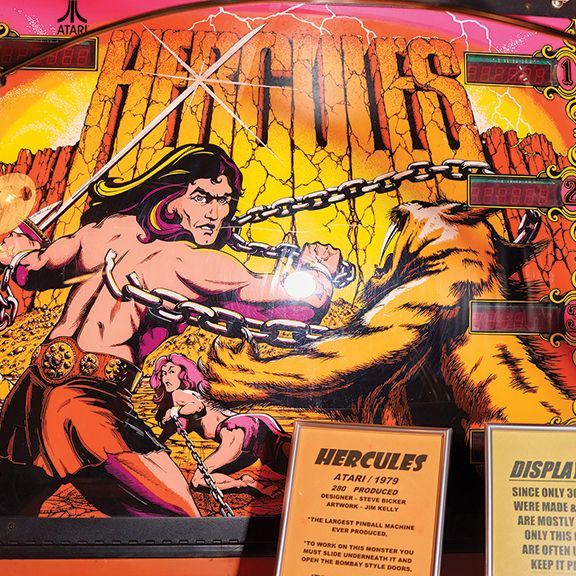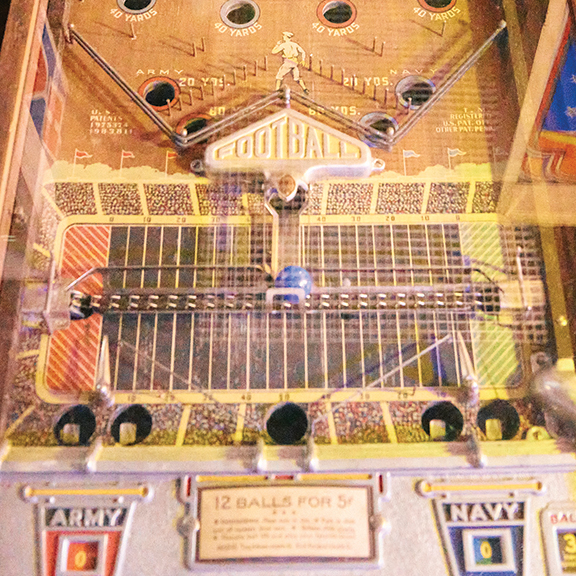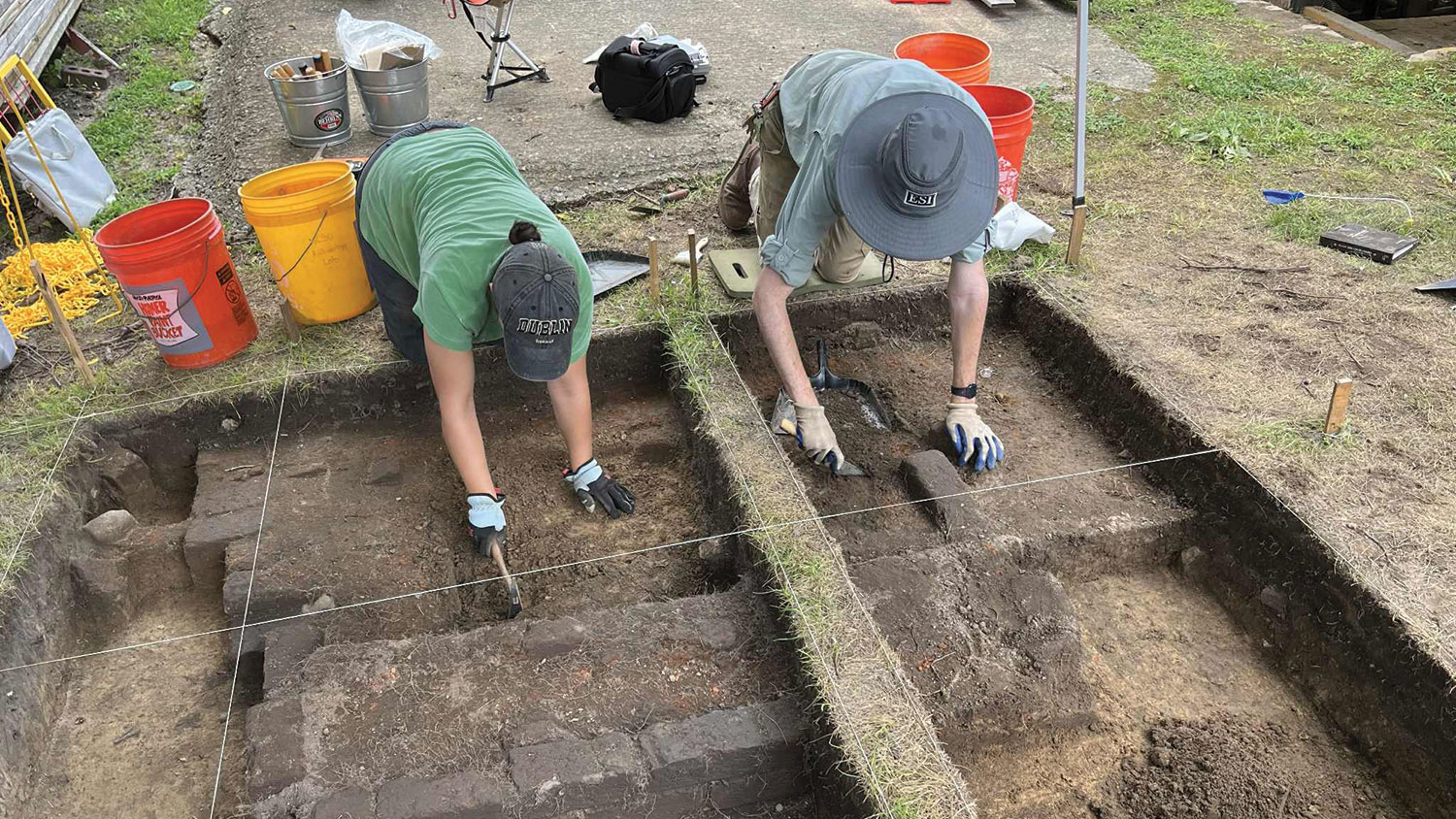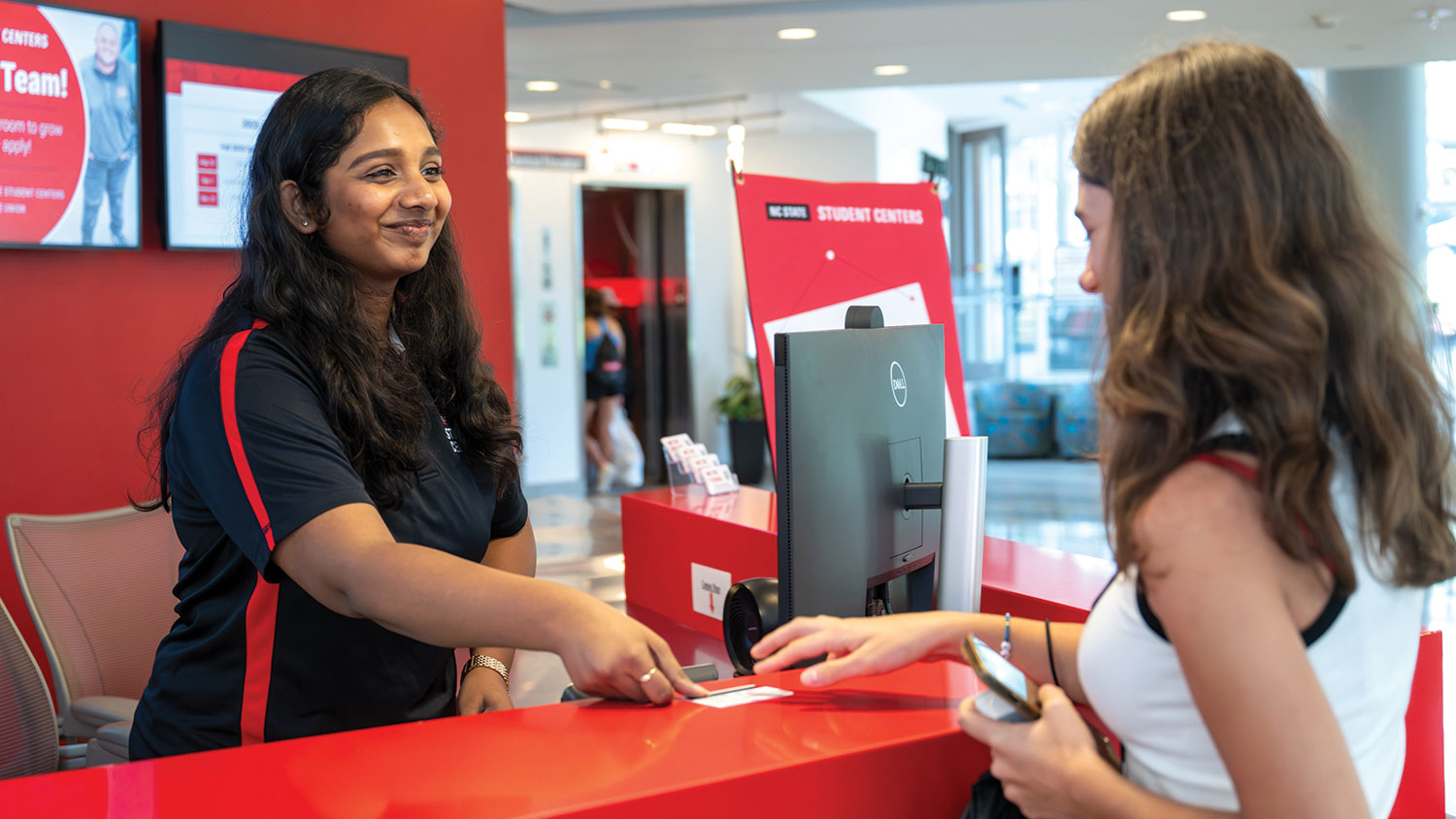The Flip Side
T.C. DiBella ’97 MED has pushed all the right buttons to make the Asheville Pinball Museum an unforgettable experience.

Asheville, N.C. — It’s a late May morning, and museum owner T.C. DiBella ’97 MED is showing off his latest acquisitions. They are eight miniature figurines, and each no more than two inches tall. He came across them in a Kure Beach, N.C., convenience store on a recent vacation. Decorative and colorful, the figures are all characters from the classic video game series Street Fighter. He saw them just lying around, asked the clerk if they were for sale and paid $2 each.
DiBella is giddy as he talks about these little finds. He needs four more to complete the set, and he has big plans for them once he’s amassed the complete collection. He points out his favorite one — Blanka, a fierce green man with orange tufts of hair — and relays the character’s backstory: “As a small child he was lost after a plane crash in Brazil and was raised in the jungle, and now he can charge himself with electricity and shock his opponents,” DiBella says. “It makes very little sense, but it is very cool.”

DiBella has made a career finding things that are “very cool.” It’s his instinct, spotting the marriage between the senseless and hip, kitsch and nostalgia, and selling it. He’s been doing it since he can remember, collecting everything: comic books, toys, movie posters and lunchboxes. A former middle school social studies and science teacher, he used to designate Fridays “Jersey Day” and used it as a chance to show off one of the 50 professional sports jerseys he’s collected from the NBA, NHL, NFL and MLB.
All those playthings and curios are on full display in downtown Asheville inside DiBella’s empire of novelty. But they are only ancillary to the truest passion DiBella chose to dedicate his life and business to: pinball. In 2013 he opened the Asheville Pinball Museum; today it’s an electrified landscape of glowing reds, oranges, greens and blues, emphasized by black-painted ceilings. That ambience is complemented by pinging silver balls and the dissonant rhythm of flippers, high-score bells and laser sound effects. In the last decade, DiBella has built the museum into one of Asheville’s top attractions and a thriving business, welcoming tens of thousands of visitors a year.

“Nostalgia is a big part of it,” DiBella says. “But discovering our place, I think a lot of people take pride, like, ‘Oh, we just walked up on it.’ Younger people, a lot of them, have never seen pinball. So, they’re fascinated by it, and in this digital age, it’s a real thing. You’re controlling a real thing. That ball is being controlled by you. And it’s tactile. People enjoy that.”


More Than a Game
DiBella, 58, was intentional with wording when he named his business the Asheville Pinball Museum. “It’s not what you think. It’s not a barcade. It’s not just an arcade,” he says, although there is a bar that sells snacks and beer. “It is what I said it is: It’s a pinball museum.” And, just like other museums, visitors pay a flat fee for all-day admission, with a day of pinball set at $17.
It isn’t a stuffy museum (though DiBella has placed placards atop every machine explaining their history and showing how many units were produced); it is an interactive museum, with 40 pinball machines on the main floor and a section in the back full of 40 classic arcade hits, like Galaga, Space Invaders and Dragon’s Lair (because, he says, underscoring the obvious, “Of course Dragon’s Lair”). A video jukebox plays classic hits from the ’80s in the space. Think Duran Duran meets Dig Dug.

In DiBella’s office a sign reads, “Temet Nosce.” Some might know it as a Latin phrase that translates as “know thyself.” Others might know it as the exact sign featured in the film The Matrix. But it’s informative in that it sums up DiBella’s approach to curation: He knows he’s a Gen-X collector, and he’s attracted to just about anything from 1960s, ’70s or ’80s pop culture. He can get any Burt Reynolds reference you throw his way. He’s got the Batmobile license plate from the ’60s television show on display, authentically reading, “2F-3567 Gotham 1966.” Portraits of his favorite stars line the walls: The Golden Girls’ Betty White, The Rockford Files’ James Garner and the Coneheads, to name a few. If you can’t remember what a delightful year 1987 was, there’s a David Lee Roth calendar hanging up to remind you. There’s always an Album of the Week featured on the bar (Larry Gatlin & the Gatlin Brothers’ Straight Ahead was a late June day’s pick). And if a visitor is seeking karmic clarity, they need look no further than Kojak himself, who adorns a sign that reads: WWTSD? (That’s “What Would Telly Savalas Do?”; it can be another “TS,” too, in fact: Tom Selleck, Tony Stark or Taylor Swift.)
While all those set the mood, DiBella’s pinball machines take visitors way back as effectively as a ride in a DeLorean alongside Marty McFly. There are iconic Harlem Globetrotters and Evel Knievel machines from Bally, which was a leading producer in the 1970s. There’s also Captain Fantastic and the Brown Dirt Cowboy, released in 1976, a year after Elton John’s album of the same name dropped. DiBella qualifies the machine as his first true find. (“[It] was literally in a horse barn with a horse in the stall beside it.”)
Visitors learn that Atari produced the only Superman pinball game ever released, in 1979, with a run of 4,200 machines. There’s Humpty Dumpty, the first pinball game with flippers. It came out in 1947, and is a bit backward, literally — the flippers face outward instead of the more traditional inward design.
There’s the Army Navy machine from the early 1930s, one of the oldest in the collection and out only for display.
In the front corner of the museum, there’s the mammoth orange machine Hercules that Atari released in 1979. “Only 280 were made,” DiBella says. “We did let people play this when we first opened, but now the flippers have gotten very weak. It uses an 8-ball. The flippers can’t get the ball but so far. Plus, it uses so much power to activate the flippers and the pop bumpers that we’d have to turn off like three [other] machines.”





It’s one of about a dozen that are out only for display. DiBella takes pride in the fact that the Asheville Pinball Museum starts every day with each machine up and running. And should one encounter a problem, it’s usually something minor, like a stuck ball. “We don’t put ‘Out of Order’ signs on our machines,” he proudly says. “We put ‘Ready Soon’ because a lot of times we can get to it.”
If it’s something more major, there’s a vast online community on the website Pinside, where DiBella can connect with other dealers, players and collectors.
When DiBella talks about repairs, he uses the analogy of antique cars. “If you had a ’67 Mustang, you could find an old ’67 Cougar and [get] parts out of it. They’re made in the same factory,” he says. “Same thing with pinball machines.”
The Asheville Pinball Museum has gone from 27 pinball machines when it opened up in 2013 to 120 pinball and 100 arcade games in the collection today. DiBella opened a second location, the Appalachian Pinball Museum, in Hendersonville, N.C., in 2017 with his partners — his wife, Brandy, and a friend. He says his collection has grown in value from about $18,000 to $500,000. Pinball machines can cost thousands of dollars, arcade games hundreds. And just like with cars, “You’re always trying to trade up,” DiBella says.
He has a list of about 10 machines he’s trying to locate, and he’s currently considering a trip to Indiana to pick up a Batman machine based on Christopher Nolan’s The Dark Knight. The farthest he’s ever driven is just west of Chicago, and that was to pick up a BurgerTime arcade machine from a guy making them in the Midwest.
Every trip is worth it to accomplish what DiBella sees as the museum’s purpose. “The best part is just seeing people happy,” he says. “I know it’s silly, but it’s true.”
Visitors are more than just happy. Dads walk around in awe. Mothers walk around and snap pics to send to their daughters who used the very same Strawberry Shortcake lunchbox on display. Couples compete and laugh at besting each other. Families buy Asheville Pinball Museum caps and shirts.

“We’re Wrigley Field and Fenway Park,” DiBella says. “We’re small, but we’re packed.”
There are a lot of Gen Xers. A lot of young kids, too. There are tourists, killing time before dinner. And there are arcade nerds chasing high scores. During summer, the museum’s high time for visitors, DiBella says it welcomes 5,000 to 6,000 patrons a month. At peak times, the museum’s 70-person capacity leaves some visitors standing in line outside, waiting until a spot opens inside.
Holly Gordon is a visitor on a late-June day. Her family is visiting from southern Indiana. They come to Asheville every two years, and the Asheville Pinball Museum is always high on the list for her family, including her 10-year-old son, Eli, who is wowed by the Attack from Mars machine.

“It’s incredible. The vintage vibe is unmatched,” she says, adding that all the knickknacks, like the rotary phones on display, bring back feelings from her past. “It makes me want to go home and dig in my parents’ attic.”
Electronic Enlightenment
DiBella’s approach for the Asheville Pinball Museum, to fuse play and education, makes sense given his former profession. He came to NC State from Harnett County, N.C., in the mid-1980s and made Dick Sheridan’s football squad as a walk-on. He later transferred to Appalachian State University and went on to teach middle school science and social studies all around the state for 22 years.
He says the idea for the museum came to him in early 2013 after his wife got him his first machine, Buccaneer, for their basement. He remembers having colleagues over to let off steam, and all they wanted to do was play pinball. He formulated the idea in March, and by August, he was open for business in downtown Asheville. “It didn’t take that long,” he remembers, adding that he did his own market research in the intervening months, studying what online reviewers said about a handful of other pinball museums in Seattle, Wash., and New Jersey. He specifically studied the negative reviews and knew what he wanted to provide in his museum: a flat rate for all-day play, instead of having to feed each game quarters, and machines that worked dependably.
So he gave Asheville players that, plus some knowledge. Let’s call it his own version of the bonus play offered by an extra ball.
“I love sharing knowledge,” says DiBella, who tried to teach and run the museum for about six months before retiring to give pinball his full attention. “I have a very active imagination. I see something cool, and I say, ‘How can we work that into the museum?’”

That’s why he obtained a phone booth, put it in the back of the museum and turned it into an homage to the film Bill & Ted’s Excellent Adventure. It’s why he also opened two more museums in 2021, the Amazing Poster Vault and the Lunch Box Hall of Fame, in the basement of his current location. “I’ve got over 200 lunch boxes. So, you name it, I pretty much have it,” he says. “We charged $1 a person down there, and … we’re somewhere between 11,000 and 12,000 [total visitors].”

Both auxiliary museums were casualties last September when Hurricane Helene tore through western North Carolina, though DiBella says he will reopen them one day. For now, some posters and lunch boxes have found their way into the pinball museum, along with figures like Boba Fett, André the Giant and Domino’s Pizza’s the Noid that sit behind the bar. The TWIPY (the annual Pinball Community Award) the museum just won for “Best Location — US Southeast” is on full display, too.
If you stop in for a visit one of the six days a week the museum is open (it’s closed Tuesdays for repairs), you’ll see them as well as the garden gnomes that line the museum’s window (they protect it, DiBella says). You’ll see a celebrity wall of fame, featuring pictures of famous visitors to the museum, including Owen Wilson, Danny McBride and Nine Inch Nails frontman Trent Reznor (“He was a kid in a candy store,” DiBella remembers). You’ll see DiBella occasionally walk around and talk to the visitors, engaging them like the teacher that he still is in a roundabout way, as well as checking if there are any intriguing high scores on Asteroids and Robotron: 2084, which he tries to beat by playing each game once a day. You might see him inducting a player into a secret pinball society, knighting them with a sword made from the steel of pinball machine legs.

As for DiBella’s plans for his new Blanka and other Street Fighter figurines, when he gets the four he lacks — a matter of when, not if — he plans on mounting them atop the actual Street Fighter game in the museum. Just a little extra ornamentation. Just a little extra something to capture visitors’ attention. But all the more, it’s a flourish signifying what DiBella believes makes the Asheville Pinball Museum such a memorable visit.
“I let the machines do the talking.”
Photography by Joshua Steadman
A Timeline of Tilt
Based on a French game known as bagatelle, pinball made its first splash in America in the 1930s. Soon after the game got rolling, it was surrounded by controversy, with politicians and others bothered by how it had captivated youth and resembled gambling games of chance. But pinball enthusiasts played the long game, waiting until the 1970s to see it thrive. The pastime still shines bright today at places like the Asheville Pinball Museum.

- 1932
Ballyhoo, considered by many pinball insiders to be the first commercially released machine, is developed by Bally, one of the most iconic companies to produce pinball machines. Ballyhoo features pins, like bagatelle, that catch the ball as the player moves the board, influencing the ball’s path. These pins are the origin of the name “pinball.”
- 1942
The New York City Mayor Fiorello La Guardia leads a movement to ban pinball. Machines are confiscated and destroyed.

- 1947
Humpty Dumpty is released by Gottlieb, introducing flippers to machines for the first time.
- 1969
The Who’s rock opera album Tommy is released, detailing Tommy Walker’s rise to “Pinball Wizard.” The movie adaptation is released six years later. From Soho down to Brighton, no one played like Tommy.
- The 1970s
A new era of pinball is introduced with the development of solid state, or “SS,” machines. These machines use a microprocessor for the first time, marking a change from the electromechanical machines, or “EMs,” that dominated the industry the prior four decades and used a system of wires and electric relays.
- 1971
Gottlieb releases Challenger, one of the first two-player machines. Players compete against each other at opposite ends of the machine, which is equipped with a playfield that alternately tilts like a seesaw.

- 1976
Journalist and pinball fanatic Roger Sharpe plays a game to prove that pinball is based on skill, not on chance. This changes its perceived proximity to vice and causes the New York City Council to lift the ban.
- 1979
Gorgar is released by Williams. It’s the first game to feature a speaker, allowing the demon Gorgar to address the player.
- 1981
The iconic game Eight Ball Deluxe makes its debut, representing pinball’s push to remain relevant amid the dawn of video games.

- 1992
What many consider to be the most popular machine ever, The Addams Family, hits the market a year after the release of the popular film. It sells 20,000 units.
- 1999
Trying to stay viable amid the arcade decline, a new age of pinball is introduced with games like Revenge from Mars, featuring advancements like interactive game play. It is a sequel to the popular Attack from Mars game.
- 2021
Godzilla is released and is the most popular contemporary game. Machines are still released to great anticipation and demand from the pinball insiders.

Note on sources: The author consulted the placards inside the Asheville Pinball Museum as well as the book PINBALL: A Graphic History of the Silver Ball by Jon Chad to provide context for this timeline.
Tell Us What You Think
Do you have a personal connection to this story? Did it spark a memory? Want to share your thoughts? Send us a letter, and we may include it in an upcoming issue of NC State magazine.


